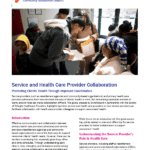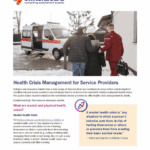In a previous post, we shared the Society of Refugee Healthcare Provider’s directory of healthcare providers who serve refugees and immigrants. In this post, we share more details about how organizations can create their own directory tailored for their location and clients’ needs.
What is this directory used for?
A health care provider directory is a centralized list of local medical providers that clients could potentially see for their health care needs. Ideally, but not always, these providers have experience or have expressed interest in caring for refugees and other newcomers. They may be clinics your organization has already established relationships with or ones you have not yet worked with.
While such a directory can be time intensive to create and keep up to date, it has many benefits:
- Saves you time when assisting clients: You can quickly find providers who meet particular clients’ needs instead of calling clinics one by one during client meetings.
- Saves your colleagues and partner organizations time and adds to collective knowledge: The list can be easily shared and updated by many people simultaneously.
- Saves institutional knowledge: If one person leaves your organization, information about these important partnerships and resources is preserved.
Tip: If your health care provider directory will be shared among different individuals or organizations, consider using a cloud-based spreadsheet so that multiple people can access and update it at the same time.
What could I include in my directory?
Your local provider directory can be as simple as keeping your own list of providers, or it can be a more detailed spreadsheet with filters depending on your capacity and clients’ needs. To get you started, we have created a provider directory template, which you can download and edit as you need.
When creating your own directory, you may consider adding the following details:
- Clinic name, along with names of any specific providers clients are seeing most often
- Provider’s gender (clients may have a preference)
- Provider/clinic’s contact information, for example, phone number, fax number, website, etc.
- City where the provider/clinic is located. If the clinic is located in multiple cities, we recommend listing the clinic multiple times, once for each city. This makes it easier when filtering your list by location.
- Medical specialty of the provider/clinic, for example, primary care, eye care, dental care, civil surgeon, medical screening provider, etc.
- Languages available. Does this provider speak languages other than English, or does the clinic have multilingual support staff? Does this provider/clinic have access to interpretation or are they willing to use interpretation arranged through insurance?
- What insurance plans are accepted? Does the provider work with Medicaid managed care organizations (MCOs)? Does the provider work with patients who are uninsured?
- Is this provider one of your preferred providers? “Preferred” means they regularly see newcomer patients, have great cultural humility, and/or have a strong partnership with you, as compared to other providers in your directory who may be newer relationships or back-up options.
- Notes section for any other useful details, such as what clients should know about traveling to that clinic or what to bring with them to the first appointment.
- Date the information was last updated, and person’s name who last updated if your directory is a shared list. This helps keep track of how fresh your information is and helps determine when you should call the clinic for an update. Clinics can change what insurance plans they accept monthly, and providers may leave or become unable to take on new patients. It is therefore important to have a regular process for updating your list.
Tip: Have your directory open when meeting with clients and assisting them with scheduling medical appointments. If the clinic mentions a change during your phone call—such as no longer accepting a certain insurance plan or a provider no longer accepting new patients—immediately make a quick note in your directory.
How can I find local providers?
If you are not finding a provider from the directory we shared previously or are in need of specific specialties, you can try:
- Asking your state refugee health coordinator for ideas
- Asking partners, such as the entity performing the refugee health screenings, as well as community-based organizations and resettlement agencies
- Calling the insurance company or checking their website for a list of providers in the area accepting the client’s insurance plan (but note that their list is often out of date, so you need to call the clinic to confirm)
- Checking with the local hospitals near clients, especially for specializations that may be less common
- Asking local medical providers you already work with for recommendations from their network of local colleagues they refer patients to
- Conducting your own community assessment (windshield or walking survey)
What is a windshield or walking survey?
- Identify what you are hoping to assess. Is it a specific kind of clinic, such as primary care, or is it any and all health care clinics?
- Identify what area you are assessing. Is it the area around your organization’s office or another key service location that clients are familiar with traveling to? Is it an area near where clients live or work?
- Print and draw on a map the area you are reviewing, and write down the types of clinics you are hoping to locate as a reminder.
- Drive or walk around the area. Search for signs indicating that clinics are present. Go into medical office buildings and take pictures of their floor directories. Write down your findings, including the clinic’s name, providers’ names, address, and phone number.
- Following the survey, organize your list. Find each clinic’s phone number online if needed. Call them to see if they work with clients’ insurance, if they are accepting new patients, and if they have access to interpretation services. Record their responses even if they do not work with clients’ insurance. It can be helpful to keep track of these providers in case their accepted insurance plans change in the future and so you know you have already contacted them.
Tip: Sometimes you can ask these questions in person as you are walking around the area. Some clinics have capacity to answer questions in the moment, while others may prefer that you call later instead. Asking questions in person can also give you an overall feel for the clinic and their staff.
Tip: Creating and keeping a directory up to date can be a great volunteer or intern project. It provides an opportunity for them to learn more about conducting community assessments and is a tangible project they can put on their resume. And it is invaluable information for you and the clients you serve!
Create a shortlist of new clinics who work with clients’ insurance, and identify good candidates to reach out to for more in-depth conversations. You may want to ask their staff if they are interested in learning more about refugees and newcomers, and explore if they would be willing to use interpretation services. You can also start referring clients to them and start establishing a relationship that way.










